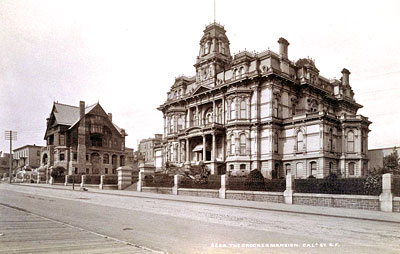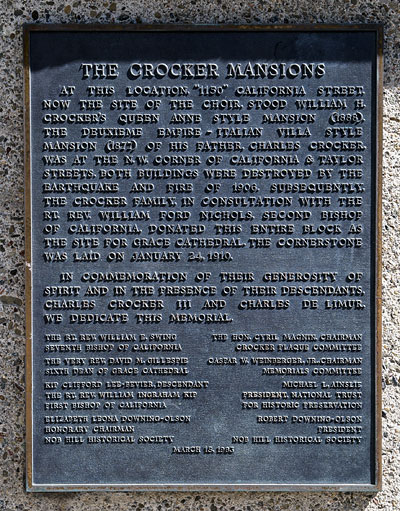William F. Curlett (1874-1916)
 Charles Crocker Mansion on Nob Hill
Charles Crocker Mansion on Nob Hill
Designed by Curlett & Cuthbertson
Prior to 1906 Earthquake and Fire
Courtesy Bancroft Library, UC Berkeley
(Click Photo to Zoom)
 Plaque on the Wall of Grace Cathedral
Plaque on the Wall of Grace Cathedral
Near California Street Entrance
The Crocker Mansions
At this location "1150" California Street, now the site of the choir, stood William H. Crocker's Queen Anne style mansion (1888). The Deuxieme Empire - Italian villa style mansion (1877) of his father, Charles Crocker, was at the N. W. corner of California and Taylor Streets. Both buildings were destroyed by the Earthquake and Fire of 1906. Subsequently, the Crocker family, in consultation with the Rt. Rev. Willaim Ford Nichols, second bishop of California, donated this entire block as the site for Grace Cathedral. The cornerstone was laid on January 24, 1910.
In commemoration of their generosity of spirit and in the presence of their descendants, Charles Crocker III and Charles de Limur, we dedicate this this memorial.
Photographed 10 July 2012
(Click Photo to Zoom)
He was among the most prolific architects on the Pacific Coast in the final decades of the 19th and first decade of the 20th Century with a practice that typified the successful architectural profession of that period. Contacts with the gentry and well-heeled were of paramount importance. Curlett had his wealthy friends both in San Francisco and Los Angeles. He built many buildings, both public and private, in each city and throughout California.
He possessed another trait critical to the success and survival of architects in his time, the ability to adapt the current stylistic vogue to one's own design. During some forty years of practice, he designed buildings of many different styles.
His residences ranged from flamboyant Victorian (the Crocker Mansion and the Payne Residence in San Francisco) to sober Roman Renaissance (Villa Montalvo in Saratoga and the Payne country home in Menlo Park).
His commercial and public projects ranged in style from Richardson Romanesque (Los Angeles County Courthouse and the California State Bank in Sacramento) to an eclectic combination of Classic, Roman, and Flemish forms (Mutual Savings Bank in San Francisco.)
Adapted from NRHP Nomination Form #80000847: Theodore F. Payne Residence

William Curlett and Walter Cuthbertson designed the Charles Crocker and William H. Crocker houses on the present site of Grace Cathedral.
Willis Polk regarded the Charles Crocker house as the ugliest building in the city and offered to burn it down as a civic gesture.
Curlett spent the later years of his life in Los Angeles and was elected President of the State Board of Architects.
Adapted from the Phelan Building website
| Name | Year | Address | City | Sort Address | Sort Name |
|---|---|---|---|---|---|
| Packard Library | 1905 | 301 4th Street | Marysville | Street 04 0301 | Packard Library |
| Frederick Post Company | 1906 | 133-137 Second Street | San Francisco | !Street 02 133 | Frederick Post Company |
| MacDonough Building | 1907 | 333-343 Kearny Street | San Francisco | Kearny 0333 | MacDonough Building |
| Clunie House | 1897 | 301 Lyon Street | San Francisco | Lyon 0301 | Clunie House |
| Mutual Savings Bank | 1902 | 704 Market Street | San Francisco | Market 0704 | Mutual Savings Bank |
| Phelan Building | 1908 | 760-784 Market Street | San Francisco | Market 0760 | Phelan Building |
| Federal Hotel | 1912 | 1083-1087 Market Street | San Francisco | Market 1083 | Federal Hotel |
| Haas Candy Factory | 1907 | 54 Mint Street | San Francisco | Mint 0054 | Haas Candy Factory |
| Villa Montalvo | 1892 | 15400 Montalvo Road | Saratoga | Montalvo 15400 | Villa Montalvo |
| Head Building | 1909 | 201-209 Post Street | San Francisco | Post 0201 | Head Building |
| Shreve Building | 1905 | 210 Post Street and 201 Grant Avenue | San Francisco | Post 0210 | Shreve Building |
| Payne Residence | 1881 | 1409 Sutter Street | San Francisco | Sutter 1409 | Payne Residence |